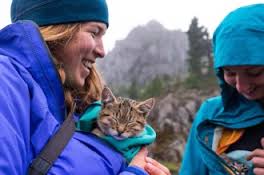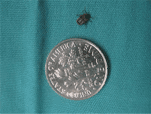Living Nine Lives To The Fullest
Laura Moss, Adventure Cats
 You probably think you know all there is to know about cats, but what about taking your cat into the wild? When animal writer and active hiker Laura Moss couldn't find an online resource for hitting the trail with her cat, she created one. In her book, Adventure Cats, you will find cats that walk on a leash, cats that hike on a leash, cats tramping through snow, camping cats, kayaking cats, canoeing, even surfing—yes, cats who love water!
You probably think you know all there is to know about cats, but what about taking your cat into the wild? When animal writer and active hiker Laura Moss couldn't find an online resource for hitting the trail with her cat, she created one. In her book, Adventure Cats, you will find cats that walk on a leash, cats that hike on a leash, cats tramping through snow, camping cats, kayaking cats, canoeing, even surfing—yes, cats who love water!
Laura has two cats at home and they both enjoy leash walking. Laura didn't train them on a leash until they were about 3 and 5 years of age and she keeps her cats' adventures close to home, as her backyard is full of trees and has a stream for them to explore. She doesn't feel they are ready to join her on a camping trip quite yet.
For many years, Laura has written about cats and had the privilege of interviewing a lot of the famous adventure cats like Millie the climbing cat and Burma the adventure cat. This made her curious as to how people went from basically leash training their cats to walk around the yard to scaling peaks and going on overnight trips. This is how her interest in adventuring with a cat got started and why she created her website.
Surprisingly, Laura found out that there were a lot more people going on adventures with their cats than she imagined, and her website is a central part of the cat community for people to share stories and pictures of amazing adventures they've taken with their cats.
 In Laura's book Adventure Cats, you will find stories of the one-eyed cat who hangs ten; to Georgie, a four-year-old gray tabby who lives on a sailboat; to Quandary, who not only insists on hiking with her family but also teaches them a valuable lesson.
In Laura's book Adventure Cats, you will find stories of the one-eyed cat who hangs ten; to Georgie, a four-year-old gray tabby who lives on a sailboat; to Quandary, who not only insists on hiking with her family but also teaches them a valuable lesson.
Out of all the stories that she's heard, Laura tells us the story that still amazes her is the cat that enjoys swimming in the ocean. There are two women who are special education teachers in Hawaii and they have a rescued cat named Kuli. Kuli has a lot of health problems including an eye infection. He had to be bathed quite frequently because of this and he became very comfortable with water. Now, Kuli paddles around with them in the water and enjoys the waves. Laura thought she would never believe it until she saw it. After talking to the women and seeing videos, along with all of the safety precautions they take, you can tell Kuli is enjoying what he is doing.
Adventures are not for all cats. So how can you tell if your cat is one who would like to go on adventures? Laura said look at your cat. If your cat enjoys watching cat TV or looking out the window, or if he is constantly trying to get outside or even acting out with behavioral issues, it might be worthwhile to get him outside for the physical activity and mental stimulation, However, just because you have a cat who is showing all of these qualities, doesn't necessarily mean they are going to take to adventures. You can also take the quiz at the beginning of her book Adventure Cats to find out!
 If you are going to take your cat outside to see if they like it, Laura suggests finding a harness that fits your cat and start leash training indoors first. Then slowly start taking them outside and see how your cat responds to the environment. Some cats are easy to leash train, while others are impossible. Laura suggests first letting your cat sniff the harness before even thinking of putting it on them. Next, feed them treats next to it. After a while, put it on them without hooking up a leash. You may not even want to clip the harness's enclosure, as just the sound may scare them until they get used to it. When your cat feels comfortable with this, you can hook up the leash and take them outside when you think they are ready. Some cats will get used to the harness and leash in a few days while others may take weeks. Then, there are the ones that will never get used to it - so they probably wouldn't want to go on an adventure anyway! Just remember - your cat is calling the shots. If you push them too far too fast, they may never want to even go near a harness again.
If you are going to take your cat outside to see if they like it, Laura suggests finding a harness that fits your cat and start leash training indoors first. Then slowly start taking them outside and see how your cat responds to the environment. Some cats are easy to leash train, while others are impossible. Laura suggests first letting your cat sniff the harness before even thinking of putting it on them. Next, feed them treats next to it. After a while, put it on them without hooking up a leash. You may not even want to clip the harness's enclosure, as just the sound may scare them until they get used to it. When your cat feels comfortable with this, you can hook up the leash and take them outside when you think they are ready. Some cats will get used to the harness and leash in a few days while others may take weeks. Then, there are the ones that will never get used to it - so they probably wouldn't want to go on an adventure anyway! Just remember - your cat is calling the shots. If you push them too far too fast, they may never want to even go near a harness again.
Laura tells us you always have to have your cat's best interests in mind. If you're going to take your cat to a park or a wildlife area, you need to keep your cat on a short leash. You also need to know the area very well before taking them there. If there are a lot of wildlife sightings, maybe that is an area you need to avoid. If it's warm outside, avoid tall grass that might hide snakes. Don't let your cat poke around in crevasses like under logs or in holes. These precautions are pretty much the same if you were taking a dog out.
Laura has been an outdoors lover and total cat lady all her life. She's written about pets professionally and is the mother of a timid rescue dog and two mischievous rescue kitties that she's clicker and leashed trained.
Visit Website
Our Mysterious Feline Companions
Thomas McNamee, The Inner Life of Cats
 For millennia, cats have been celebrated as secretive, mysterious companions, content to live alongside (but apart from) humans. Thomas McNamee shares the science revealing cats' hidden depths of emotion and affection for humans in his book, The Inner Life of Cats. He tells us that the hero and inspiration of the book was a little black kitten named Augusta.
For millennia, cats have been celebrated as secretive, mysterious companions, content to live alongside (but apart from) humans. Thomas McNamee shares the science revealing cats' hidden depths of emotion and affection for humans in his book, The Inner Life of Cats. He tells us that the hero and inspiration of the book was a little black kitten named Augusta.
Thomas and his wife live on a remote ranch in Montana. One December there was a tremendous blizzard and the next morning Thomas went out to the barn looking for something. While searching, he saw a little black kitten running around. He knew it was impossible for it to have come from somewhere else, because they lived in the middle of nowhere. It was then that he saw tracks in the snow down his driveway, which is a quarter mile long from the county road. He saw little tiny dime-sized footprints leading from the county road. Thomas was 25 miles from the nearest town, so someone had come out there to dump this kitten in a blizzard. Thomas feels they might have also dumped several other kittens in the valley, which probably didn't survive.
The kitten was named Augusta by Thomas and his wife and they kept her and raised her. However, he felt that they didn't really do a great job in raising her because they really didn't know what they were doing. Through the course of this kitten's life, they learned a lot about her. But they also learned later that they'd made a lot of mistakes. Augusta had phobias and various other problems all her life.
In looking back over Augusta's life when she had passed away after 15 years, Thomas realized as he began to learn more about cats, that there might be a book telling people about mistakes in raising cats and the good things one can learn about cats if only the scientific literature, of which there is a lot he found after 20 years of research, were brought forward to the broad public. He then combined the story of Augusta with a lot of science in his book.
 The biggest thing that Thomas found in his research was a paper that was published in Switzerland from a conference in the 1980's that never made it to broad distribution, by Eileen Karsh. Karsh discovered that you should nurture cats from an extremely early age, as early as 2 weeks, with human handling and human noises and voices, along with human disturbances like vacuum cleaners and car horns. Because of the way a cat's brain develops, if they have that kind of human contact and love that early, you get a much sturdier, braver, peaceful cat. People usually start to handle kittens at the ages between 7 and 12 weeks. But if it's started a lot earlier, you get a much more sturdy and reliable cat.
The biggest thing that Thomas found in his research was a paper that was published in Switzerland from a conference in the 1980's that never made it to broad distribution, by Eileen Karsh. Karsh discovered that you should nurture cats from an extremely early age, as early as 2 weeks, with human handling and human noises and voices, along with human disturbances like vacuum cleaners and car horns. Because of the way a cat's brain develops, if they have that kind of human contact and love that early, you get a much sturdier, braver, peaceful cat. People usually start to handle kittens at the ages between 7 and 12 weeks. But if it's started a lot earlier, you get a much more sturdy and reliable cat.
Thomas explains that what cats need from humans to survive and thrive are understanding, care and an appreciation for their emotional depth and complexity. He tells us that cats are complicated and emotionally very sensitive. However, most people feel that cats are aloof and they don't care about anything or anybody, but that's not true.
Thomas shows that with a deeper knowledge of cats' developmental phases and individual idiosyncrasies, we can do a better job of guiding cats' maturation and improving the quality of their lives. Readers' relationships with their feline friends will be happier and more harmonious because of his book. Thomas explains that it takes some work to come to understand cats and their body language. But once you do, you will be richly rewarded!
The book was written with guilt, but Thomas hopes it will end in illumination.
Augusta has since passed away and Thomas now has a Bengal cat named Isabel. Isabel is not full Bengal, just part. He tells us that the top half of her is Bengal and underneath she is tabby. She is taller than a tabby and has spots instead of stripes and is also a little more athletic. She also has the Bengal nose, which is flat like a lion's, and doesn't meow like a regular cat and that she is great!
Visit Website
Ticks Hitchhike on City Dogs Too - Dr. Debbie
 Ticks are common parasites known to infect people, pets and spread disease. Over 850 tick species exist worldwide, although fewer than a dozen species are of risk to pets in the U.S. But here in Las Vegas, pet owners often dismiss the existence of ticks with the likes of Bigfoot or the Loch Ness Monster. Think ticks are only a problem for pets that travel or visit the mountains? Think again.
Ticks are common parasites known to infect people, pets and spread disease. Over 850 tick species exist worldwide, although fewer than a dozen species are of risk to pets in the U.S. But here in Las Vegas, pet owners often dismiss the existence of ticks with the likes of Bigfoot or the Loch Ness Monster. Think ticks are only a problem for pets that travel or visit the mountains? Think again.
The Tick Tale
Ticks are parasites known to infect mammals, reptiles and birds and feed on their host's blood. Although of tiny size, ticks ingest 200 to 600 times their weight in a blood meal.
Ticks are attracted to a host's movement, body warmth or exhaled carbon dioxide and then latch on. Through this feeding behavior they can transmit diseases to pets such as Lyme disease, Rocky Mountain spotted fever, Ehrlichia, Babesia and Tularemia. Disease transmission takes some time and may occur after 36 to 48 hours of feeding behavior.
Some ticks can live months or up to a year off its host without a feeding, so year-round prevention is important for pets at risk for continued exposure.
Battling Ticks
There are many topical tick control products available for pets. Speak with your veterinarian for a product that is effective and safe with your pet's individual health in mind. Cats are sensitive to some ingredients, may develop toxicity, and should never be treated with a product labeled only for dogs. Additionally, pet owners using multiple products on their pet should first consult with their veterinarian to ensure safe use of combined products.
In addition to topical tick control, environmental treatment with foggers, sprays or pest control service should be considered for heavy infestations. Limit tick habitat zones by maintaining landscaping, avoiding overgrown grass and keeping shrubs and plants trimmed.
Pet Screening
Perform daily tick checks during tick season. Examine your pet for ticks in areas that the parasites hang out - around the head, behind ears, armpits and between toes.
 When removing a tick, avoid handling it directly. Wear gloves or handle with Kleenex since ticks can pass infections to people as well. Grasp the tick with tweezers close to the skin. Extract the tick by pulling straight out of skin. Don't squeeze, twist or leave any legs behind. Disinfect the area and dispose of ticks in rubbing alcohol.
When removing a tick, avoid handling it directly. Wear gloves or handle with Kleenex since ticks can pass infections to people as well. Grasp the tick with tweezers close to the skin. Extract the tick by pulling straight out of skin. Don't squeeze, twist or leave any legs behind. Disinfect the area and dispose of ticks in rubbing alcohol.
Here's a photo of a typical tick, born and bred in Las Vegas and recently extracted from one of my Shih Tzu patients named Kane. Kane never leaves the state, doesn't hike in the mountains, and enjoys the comforts of a house-dog lifestyle. A tick was discovered on Kane after a day of supervising his owner's yard work and shrub trimming.
Maybe Kane's story will be an eye-opener for city dwelling pet owners. Pet parasites like fleas, ticks and mosquitoes still lurk in that urban jungle.
Featured veterinarian known as "Dr. Debbie" on national pet radio program, Animal Radio. Ebook author of "Yorkshire Terriers: How to Be Your Dog's Best Friend"; "Pugs: How to Be Your Dog's Best Friend"; "Mini Schnauzers: How to Be Your Dog's Best Friend"; and "Shih Tzu: How to Be Your Dog's Best Friend." Dr. Debbie's books.
Visit Website
5 Things To Know About Microchipping Your Pet
Robert Semrow, Listomania
 There is nothing more heartbreaking than when a pet goes missing. You can't call them on their cell phone or ping their tablet. No, it's a massive panic time as you try to remember everything you did or didn't do to help them have the best chance of getting home. We put up signs, send out social media requests for help and in the end pray for the safety and well being of our pet. We also promise ourselves and anyone listening that if we can be reunited we will make sure we do everything to insure this never happens again.
There is nothing more heartbreaking than when a pet goes missing. You can't call them on their cell phone or ping their tablet. No, it's a massive panic time as you try to remember everything you did or didn't do to help them have the best chance of getting home. We put up signs, send out social media requests for help and in the end pray for the safety and well being of our pet. We also promise ourselves and anyone listening that if we can be reunited we will make sure we do everything to insure this never happens again.
Let's start today to do something before this happens. Take an updated picture, make notes and do one of the best things that you can do for your pet - get them microchipped. This can dramatically increase the chances that you are reunited with your pet. As a reminder and to ease some fears, I am going to share some must know things about Microchipping.
To begin with, the microchip is about the size of a grain of rice. It's inserted using a needle that quickly implants the chip under the skin. Most pets never even know it's there or what occurred. The microchip emits a radio frequency to a compatible chip reader. There are different places to get one and different types as well, but most veterinary offices and clinics offer microchipping services and are aware of what is being used in your local area.
Next, and this is the most important thing once they've been chipped, make sure it is working. It is critical to have it tested and tested on a semi-regular basis. The chip can migrate and it's important to note that not all chip readers read all chips. So check with your local shelter to see if their chip reader can read the chip. If they can't, the chip does no good.
Additionally, make sure that you have filled out all of the information associated with the chip. It is important to update the information that the chip is tied to. If you move, update your new address and contact information. Many chip companies will hold additional information in their systems about the pet as well, including things like a photo, health information and more.
 Next, a microchip is not GPS. It has a code assigned to it and it is in a passive mode meaning it will only give the information when asked for as a compatible microchip reader passes over it. So don't think that this is going to tell you where your pet is, if that is what you need, there are other products on the market that do provide GPS info.
Next, a microchip is not GPS. It has a code assigned to it and it is in a passive mode meaning it will only give the information when asked for as a compatible microchip reader passes over it. So don't think that this is going to tell you where your pet is, if that is what you need, there are other products on the market that do provide GPS info.
Finally, and there is always more to know about these things, but this is one that must be said, having a microchip does not replace the need for you to have ID tags. ID tags are the first chance in the recovery of a pet. Anyone can read an ID tag, assuming it's in good shape.
So, if you have chipped your pet, add a note to check the info and the chip to make sure that they are still working. Microchipping increases the chances that you and your pet will be reunited. Share your pet microchipping tips on our Animal Radio Facebook Page.
Visit Website
Animal Radio News - Lori Brooks
 Fake Cancer Treatments Target Pets
Fake Cancer Treatments Target Pets
The U.S. Food and Drug Administration gave warning letters to 14 companies that sold more than 65 fake cancer treatments. The bogus products included pills, capsules, powders, creams, teas, oils and treatment and diagnostic kits. They were most commonly marketed and sold without FDA approval on websites and social media platforms and were usually advertised as 'natural' and often falsely labeled as dietary supplements, the agency added. "Consumers should not use these or similar unproven products because they may be unsafe and could prevent a person from seeking an appropriate and potentially lifesaving cancer diagnosis or treatment." But the intended target for these phony treatments isn't just people. Unproven cancer treatments for pets are also very common, according to the FDA. The government agency says that bogus remedies claiming to cure cancer in cats and dogs show up online. People who cannot afford to spend large sums at the animal hospital to treat cancer in their pets are searching for less expensive remedies and increasingly becoming victims of the phony cancer cure scams.
 Think Twice Before You Put Your Pet On A Plane
Think Twice Before You Put Your Pet On A Plane
United Airlines investigated an incident where one of the world's biggest rabbit, a three-foot Continental Rabbit named Simon, was found dead after a plane had landed from a flight from London's Heathrow airport to Chicago's O'Hare. Simon travelled in the cargo hold and didn't survive the trip. His owner says he had a vet check-up three hours before the flight. Well, it turns out that United had the most animal deaths of all U.S. airlines that year on scheduled domestic and international passenger flights. It had 9 deaths of animals and 14 injuries, meaning it had 2.1 incidents involving the transportation of animals per 10,000 in 2016. Delta Air Lines was next on the list and had 5 animal deaths on flights and 5 injuries, following that is American Airlines, which had 4. However, be aware that there are also numerous injuries that have been reported due to pawing and chewing metal cages during a flight. Ironically, United has a program called PetSafe to transport animals that are not eligible to travel in the aircraft cabin, but don't let that program name fool you. The Humane Society of the United States strongly discourages having your pet travel by air in the cargo hold of a plane, saying it can be dangerous and stressful. Cats, for instance, do not enjoy change and taking them on trips is usually not a good idea. For the record, each airline is required to report the total number of animal incidents for the entire calendar year and the total number of animals transported in the calendar year.
LA Bans All Displays of Performances By Wild Animals
Years ago, Los Angeles banned the use of elephant bullhooks within city limits. A bullhook is a heavy metal tool that looks like a fire poker and is used to train and guide elephants. The move made it much harder for Ringling Bros. & Barnum and Bailey to bring its famous elephants to town and it eventually resulted in the circus's decision to retire its elephants and completely shut down its circus. Along with this, Los Angeles became the largest U.S. jurisdiction to ban all displays or performances by wild and exotic animals.
 Dog Gets Gender Reassignment Surgery
Dog Gets Gender Reassignment Surgery
A pet dog underwent gender reassignment in a rare operation after vets discovered she was a hermaphrodite, meaning medical experts discovered that the dog was born with both male and female external body parts. Molly, a Jack Russell, made a complete recovery after undergoing the rare gender reassignment surgery. Her parents took her to the vet when they noticed her unusual toiletting behavior when she was a puppy. They noticed that around the house Molly would squat to urinate but outside she would lift her leg.
Deadliest Animal Kills About 120 People Yearly - This Animal Will Surprise You!
According to data from the Centers for Disease Control, pit bulls are NOT the deadliest animals, or even rattlesnakes. Believe it or not, deer are the deadliest animals in America, responsible for killing 120 people on average every year. This compares to one person a year (on average) being killed by bears, alligators and sharks and 0.23 people killed by rattlesnakes. Deer are normally not violent, but the majority of the deaths caused from deer stem from car accidents. Your chances of being impacted by deer deaths depend on where you live. The report found that the states with the lowest odds of dying by any animal are on the East Coast, with Massachusetts being the lowest, but Montana residents have the highest odds of dying by an animal.
 Drug-Sniffing Lizard Gets Sworn Into Duty
Drug-Sniffing Lizard Gets Sworn Into Duty
An Arizona police department was the talk of the town after sharing photos from the swearing-in of its most unusual officer, Iroh the drug-sniffing lizard. Iroh is actually a bearded dragon that first came to the Avondale Police Department last April as part of a pilot program. He was officially sworn in and photos of the ceremony were posted to the department's official page on Facebook. Iroh was originally brought in after officials reviewed research indicating reptiles have a strong enough sense of smell to make them more effective than dogs at detecting some types of narcotics. If you are a reptile lover and would like to follow Iroh, just use the hashtag "#IrohAdventures" in your search. (FYI - this was an April Fool's Hoax)
 Listen to the entire Podcast of this show (#1174)
Listen to the entire Podcast of this show (#1174)





